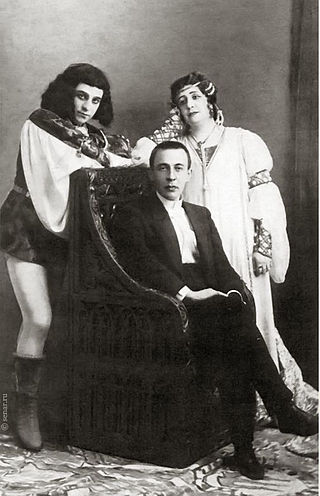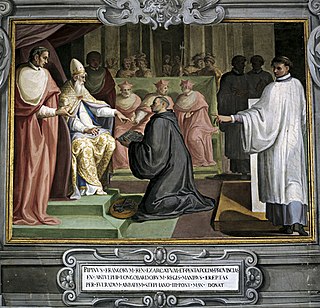Primate is a title or rank bestowed on some important archbishops in certain Christian churches. Depending on the particular tradition, it can denote either jurisdictional authority or (usually) ceremonial precedence.
Malatesta da Verucchio (1212–1312) was the founder of the powerful Italian Malatesta family and a notable condottiero. He was born in Verucchio. He was the son of Malatesta della Penna (1183-1248).

Sigismondo Pandolfo Malatesta was an Italian condottiero and nobleman, a member of the House of Malatesta and lord of Rimini and Fano from 1432. He was widely considered by his contemporaries as one of the most daring military leaders in Italy and commanded the Venetian forces in the 1465 campaign against the Ottoman Empire. He was also a poet and patron of the arts.

Francesca da Rimini or Francesca da Polenta was a medieval noblewoman of Ravenna, who was murdered by her husband, Giovanni Malatesta, upon his discovery of her affair with his brother, Paolo Malatesta. She was a contemporary of Dante Alighieri, who portrayed her as a character in the Divine Comedy.

Francesca da Rimini: Symphonic Fantasy after Dante, Op. 32, is a symphonic poem by Pyotr Ilyich Tchaikovsky. It is a symphonic interpretation of the tragic tale of Francesca da Rimini, a beauty immortalized in Dante's Divine Comedy.

Francesca da Rimini, Op. 25, is an opera in a prologue, two tableaux and an epilogue by Sergei Rachmaninoff to a Russian libretto by Modest Ilyich Tchaikovsky. It is based on the story of Francesca da Rimini in the fifth canto of Dante's epic poem The Inferno. The fifth canto is the part about the Second Circle of Hell (Lust). Rachmaninoff had composed the love duet for Francesca and Paolo in 1900, but did not resume work on the opera until 1904. The first performance was on 24 January 1906 at the Bolshoi Theatre, Moscow, with the composer himself conducting, in a double-bill performance with another Rachmaninoff opera written contemporaneously, The Miserly Knight.

The House of Malatesta was an Italian family that ruled over Rimini from 1295 until 1500, as well as other lands and towns in Romagna and holding high positions in the government of cities in present-day Tuscany, Lombardy and Marche. The dynasty is considered among the most important and influential of the Late Middle Ages. In the period of maximum influence, they extended their domains along the Marche coast, up to Ascoli Piceno, Senigallia, Sansepolcro and Citerna, and to the north, on the territories of Bergamo and Brescia.

Fossombrone is a town and comune in the province of Pesaro e Urbino, Marche, central Italy.
Sigismondo Malatesta was an Italian condottiero.

Roberto Malatesta was an Italian condottiero, or mercenary captain, lord of Rimini, and a member of the House of Malatesta.
Malatestino Malatesta was the lord of Rimini from 1312 until his death.

Paolo Malatesta, also known as il Bello, was the third son of Malatesta da Verucchio, lord of Rimini. He is best known for the story of his affair with Francesca da Polenta, portrayed by Dante in a famous episode of his Inferno. He was the brother of Giovanni (Gianciotto) and Malatestino Malatesta.
Ferrantino Malatesta was a lord of Rimini and several other lands in northern Italy, a member of the Malatesta family.
Giovanni Maria Cornoldi was an Italian Jesuit academic, author, and preacher.

Papal appointment was a medieval method of selecting a pope. Popes have always been selected by a council of Church fathers, however, Papal selection before 1059 was often characterized by confirmation or nomination by secular European rulers or by their predecessors. The later procedures of the papal conclave are in large part designed to constrain the interference of secular rulers which characterized the first millennium of the Roman Catholic Church, and persisted in practices such as the creation of crown-cardinals and the jus exclusivae. Appointment might have taken several forms, with a variety of roles for the laity and civic leaders, Byzantine and Germanic emperors, and noble Roman families. The role of the election vis-a-vis the general population and the clergy was prone to vary considerably, with a nomination carrying weight that ranged from near total to a mere suggestion or ratification of a prior election.

From 756 to 857, the papacy shifted from the influence of the Byzantine Empire to that of the kings of the Franks. Pepin the Short, Charlemagne, and Louis the Pious had considerable influence in the selection and administration of popes. The "Donation of Pepin" (756) ratified a new period of papal rule in central Italy, which became known as the Papal States.

Francesca da Rimini and Paolo Malatesta appraised by Dante and Virgil is a composition painted in at least six very similar versions by Ary Scheffer between 1822 and 1855; all are in oils on canvas. The paintings show a scene from Dante's Inferno, of Dante and Virgil in the shadows to the right viewing the murdered lovers Francesca da Rimini and Paolo Malatesta in Hell. It "could be described as Scheffer's best work".

Paolo and Francesca da Rimini is a watercolour by British artist and poet Dante Gabriel Rossetti, painted in 1855 and now in Tate Britain.

The second circle of hell is depicted in Dante Alighieri's 14th-century poem Inferno, the first part of the Divine Comedy. Inferno tells the story of Dante's journey through a vision of the Christian hell ordered into nine circles corresponding to classifications of sin; the second circle represents the sin of lust, where the lustful are punished by being buffeted within an endless tempest.













